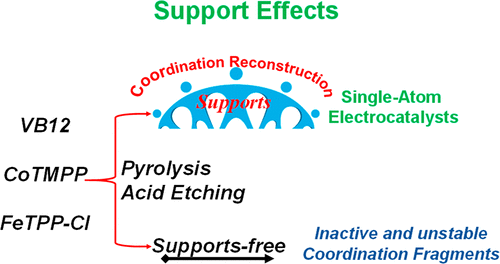当前位置:
X-MOL 学术
›
Chem. Mater.
›
论文详情
Our official English website, www.x-mol.net, welcomes your
feedback! (Note: you will need to create a separate account there.)
Tuning the Performance of Single-Atom Electrocatalysts: Support-Induced Structural Reconstruction
Chemistry of Materials ( IF 7.2 ) Pub Date : 2018-10-01 00:00:00 , DOI: 10.1021/acs.chemmater.8b02315 Gang Wan 1, 2 , Xiao-Min Lin , Jianguo Wen , Wanpeng Zhao 1, 2 , Linyu Pan 1, 2 , Jun Tian , Tao Li 3 , Hangrong Chen 1 , Jianlin Shi 1
Chemistry of Materials ( IF 7.2 ) Pub Date : 2018-10-01 00:00:00 , DOI: 10.1021/acs.chemmater.8b02315 Gang Wan 1, 2 , Xiao-Min Lin , Jianguo Wen , Wanpeng Zhao 1, 2 , Linyu Pan 1, 2 , Jun Tian , Tao Li 3 , Hangrong Chen 1 , Jianlin Shi 1
Affiliation

|
Creating active and stable electrocatalysts remains a highly desirable and critical goal in the fields of catalysis and clean energy conversion. Single-atom catalyst (SAC), as a new research frontier in heterogeneous catalysis, has demonstrated emerging prospects for many electrocatalytic reactions. Support-assisted pyrolysis approaches are widely used in the synthesis of single-atom electrocatalysts. While extensive efforts have been devoted to increase the loading of the atomically dispersed metal sites, the role of the support in creating these active metal sites remains largely unexplored. Herein, we compare catalysts created by support-free and support-assisted pyrolysis of vitamin B12 and cobalt tetramethoxyphenylporphyrin, respectively, and demonstrate an important effect of support-induced structural reconstruction that directly controls the activation of SAC. Electrochemical studies show support-free catalysts are inactive for oxygen reduction reaction whereas the support-assisted pyrolysis yields highly active catalysts using the same molecular precursors. X-ray absorption spectroscopy experiments reveal that both the metal–nitrogen coordination and the type of nitrogen species are different in these two types of samples, which leads to a difference in the d-band of the cobalt metal center and ultimately controls the catalytic activity and stability. This new insight provides a unique perspective on how to tune the electrocatalytic performances of SAC at the molecular level.
中文翻译:

调整单原子电催化剂的性能:载体诱导的结构重建
在催化和清洁能源转化领域,产生活性和稳定的电催化剂仍然是非常期望和关键的目标。单原子催化剂(SAC),作为非均相催化研究的一个新前沿,已经证明了许多电催化反应的新兴前景。载体辅助的热解方法广泛用于合成单原子电催化剂。尽管已经进行了广泛的努力以增加原子分散的金属位点的负载,但是在创建这些活性金属位点中载体的作用仍未被充分研究。在本文中,我们比较了分别由维生素B12和四甲氧基苯基卟啉钴进行的无载体热解和载体辅助热解制得的催化剂,并证明了支持物诱导的结构重建直接控制SAC活化的重要作用。电化学研究表明,无载体催化剂对氧还原反应无活性,而载体辅助热解使用相同的分子前体可产生高活性催化剂。X射线吸收光谱实验表明,这两种类型的样品中的金属-氮配位和氮的种类均不同,这导致钴金属中心的d波段不同,并最终控制了催化活性。和稳定性。这一新见解为如何在分子水平上调节SAC的电催化性能提供了独特的见解。电化学研究表明,无载体催化剂对氧还原反应无活性,而载体辅助热解使用相同的分子前体可产生高活性催化剂。X射线吸收光谱实验表明,这两种类型的样品中的金属-氮配位和氮的种类均不同,这导致钴金属中心的d波段不同,并最终控制了催化活性。和稳定性。这一新见解为如何在分子水平上调节SAC的电催化性能提供了独特的见解。电化学研究表明,无载体催化剂对氧还原反应无活性,而载体辅助热解使用相同的分子前体可产生高活性催化剂。X射线吸收光谱实验表明,这两种类型的样品中的金属-氮配位和氮的种类均不同,这导致钴金属中心的d波段不同,并最终控制了催化活性。和稳定性。这一新见解为如何在分子水平上调节SAC的电催化性能提供了独特的见解。X射线吸收光谱实验表明,这两种类型的样品中的金属-氮配位和氮的种类均不同,这导致钴金属中心的d波段不同,并最终控制了催化活性。和稳定性。这一新见解为如何在分子水平上调节SAC的电催化性能提供了独特的见解。X射线吸收光谱实验表明,这两种类型的样品中的金属-氮配位和氮的种类均不同,这导致钴金属中心的d波段不同,并最终控制了催化活性。和稳定性。这一新见解为如何在分子水平上调节SAC的电催化性能提供了独特的见解。
更新日期:2018-10-01
中文翻译:

调整单原子电催化剂的性能:载体诱导的结构重建
在催化和清洁能源转化领域,产生活性和稳定的电催化剂仍然是非常期望和关键的目标。单原子催化剂(SAC),作为非均相催化研究的一个新前沿,已经证明了许多电催化反应的新兴前景。载体辅助的热解方法广泛用于合成单原子电催化剂。尽管已经进行了广泛的努力以增加原子分散的金属位点的负载,但是在创建这些活性金属位点中载体的作用仍未被充分研究。在本文中,我们比较了分别由维生素B12和四甲氧基苯基卟啉钴进行的无载体热解和载体辅助热解制得的催化剂,并证明了支持物诱导的结构重建直接控制SAC活化的重要作用。电化学研究表明,无载体催化剂对氧还原反应无活性,而载体辅助热解使用相同的分子前体可产生高活性催化剂。X射线吸收光谱实验表明,这两种类型的样品中的金属-氮配位和氮的种类均不同,这导致钴金属中心的d波段不同,并最终控制了催化活性。和稳定性。这一新见解为如何在分子水平上调节SAC的电催化性能提供了独特的见解。电化学研究表明,无载体催化剂对氧还原反应无活性,而载体辅助热解使用相同的分子前体可产生高活性催化剂。X射线吸收光谱实验表明,这两种类型的样品中的金属-氮配位和氮的种类均不同,这导致钴金属中心的d波段不同,并最终控制了催化活性。和稳定性。这一新见解为如何在分子水平上调节SAC的电催化性能提供了独特的见解。电化学研究表明,无载体催化剂对氧还原反应无活性,而载体辅助热解使用相同的分子前体可产生高活性催化剂。X射线吸收光谱实验表明,这两种类型的样品中的金属-氮配位和氮的种类均不同,这导致钴金属中心的d波段不同,并最终控制了催化活性。和稳定性。这一新见解为如何在分子水平上调节SAC的电催化性能提供了独特的见解。X射线吸收光谱实验表明,这两种类型的样品中的金属-氮配位和氮的种类均不同,这导致钴金属中心的d波段不同,并最终控制了催化活性。和稳定性。这一新见解为如何在分子水平上调节SAC的电催化性能提供了独特的见解。X射线吸收光谱实验表明,这两种类型的样品中的金属-氮配位和氮的种类均不同,这导致钴金属中心的d波段不同,并最终控制了催化活性。和稳定性。这一新见解为如何在分子水平上调节SAC的电催化性能提供了独特的见解。











































 京公网安备 11010802027423号
京公网安备 11010802027423号